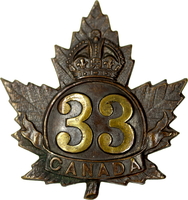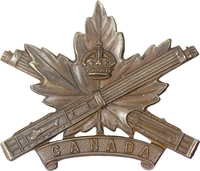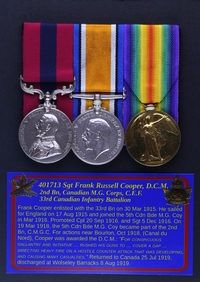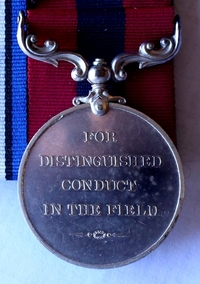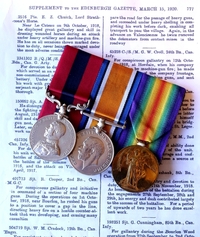
401713 Sergeant Frank Russell Cooper, D.C.M.
33rd Canadian Infantry Battalion
2nd Battalion, Canadian Machine Gun Corps
By: Capt (ret'd) Michael M. O'Leary, CD, The RCR
Frank Russell Cooper was born on 24 April 1896, in London, Ontario. He was an 18-year-old shoemaker when he attested for overseas service in the Canadian Expeditionary Force (C.E.F.) with the 33rd Overseas Battalion on 30 March 1915. Standing 5 feet, 11 ½ inches tall, Cooper was described as having a 35-inch chest, a fair complexion, greyish blue eyes, and blonde hair. He identified his father as his next-of-kin, and his address at 174 Wortley Road in south London.
Cooper's family can be found in the 1911 Canadian census. Living at the Wortley Road address in 1911 were Cooper's father (John, age 48), his mother (Sarah, age 49), Frank at age 14 (listed by his middle name, Russell), and a younger brother (John, age 12). Also identified in his service record as a family address later in the war is 189 Richmond St, London, Ont.
As a soldier of the 33rd Battalion, Frank Cooper was given the regimental number 1213, which was later changed to the C.E.F. service number 401713. His early pay records show that he was in the unit's "D" Company and that he assigned $15 per month to Mrs. E. Cooper at the family home in London. Noted as his "Widowed Mother" in the records, she later received a Separation Allowance which must have been delayed in starting because she was sent $50 per month to make up arrears starting in the spring of 1917 until early 1918 when it was reduced to $15 per month.
Frank Cooper sailed for England with the 33rd Battalion's "2nd Reinforcing Draft" aboard the S.S. Hesperian which sailed from Montreal on 17 Aug 1915. Shortly after arriving in England, he transferred from the 33rd Battalion while the unit was at Shorncliffe and joined the 9th Reserve Battalion at the Canadian Training Depot on 27 Aug 1915. Cooper was still with the 9th Res. Bn. in January 1916 when he was charged and found guilty of being absent without leave. This crime cost him a fine of two days pay, and also two days of Field Punishment No. 2, which mainly consisted of extra work on all of the less savoury general duty tasks wherever the unit was located. This period of Field Punishment is the only appearance of the military justice system in Cooper's service record.
Cooper was posted to the 5th Canadian Brigade on 8 March 1916 for service at the front. He arrived in France on 9 Mar 1916, landing at Havre and was taken on the strength of the 5th Brigade Machine Gun Company. Cooper's abilities as a soldier and NCO in the Machine Gun Corps were demonstrated by his promotion to Corporal on 20 Sep 1916 and a few months later to Sergeant on 5 Dec 1916.
Sergeant Cooper was attached to the Machine Gun School 20 May 1917. He proceeded on leave from 30 Jul to 9 Aug 1917 and rejoined his unit after leave on 14 August. Detached once again to a school, Cooper was sent On Command to the 1st Army School of Instruction on 29 Jul 1917 and did not return to his unit until 5 Nov 1917. This was followed by attendance as a student on course at Pernes from 3 Jan to 8 Feb 1918.
With the formation of the Canadian Machine Gun Corps in on 19 March 1918, the divisional and brigade Machine Gun Companies in each Canadian Division were formed into divisional Machine Gun Battalions. The 5th Canadian Brigade Machine Gun Company became one the companies of the 2nd Battalion, C.M.G.C., and Frank Cooper and his fellow machine gunners transferred to the new Corps.
Cooper would be sent to the 2nd Divisional Wing of the Canadian Corps Reinforcement Camp (C.C.R.C.) from 5 Jun to 6 Jul 1918. After returning to his unit he would go on another period of leave in the UK and be away from his unit from 15 Sep to 3 Oct 1918.
Possibly as an after-effect of Cooper's leave, he was sent from No. 55 Casualty Clearing Station rearward on No. 14 Ambulance Train with a diagnosis of Venereal Disease (Gonorrhea). Admitted to No. 4 Canadian Field Ambulance on 16 Mar 1919, he was subsequently transferred to No. 7 General Hospital, Wimereux, on 17 Mar 1919 and then to No. 9 General Stationary Hospital, Camiers, on 1 Apr 1919. Evacuated "sick,", Cooper was S.O.S. the 2nd Battalion, C.M.G.C. on 28 Mar 1919, and transferred to the Canadian Machine Regimental Depot.
Since he was hospitalized for venereal disease, Cooper was subject to standing direction that soldiers under treatment for such ailments would lose their field allowance and be subject to a stoppage of pay of 50 cents per day (equal to half of a Private's daily pay). Accordingly, Cooper was subject to those losses from 17 Mar until 16 Apr 1919, a total of 31 days. Cooper was discharged from hospital and joined the Canadian General Base Depot on 18 Apr 1919. From the Base Depot, he went to the C.M.G.C. Pool and was posted to the C.M.G.C. Depot on 27 Apr 1919.
Cooper was taken on the strength of the C.M.G.C. Depot at Seaford, reporting to the unit on 5 May 1919. On 21 May he went back to hospital, being admitted to the Canadian Special Hospital at Etchinghill, for further treatment of venereal disease. On 3 Jun 1919, Cooper was transferred to No. 11 Canadian General Hospital at Moore Barracks, Shorncliffe, until 8 Jul 1919.
For his actions near Bourlon in early October 1918, during the battle of Canal du Nord, Cooper was awarded the Distinguished Conduct Medal (D.C.M.) The initial gazette of the award, i.e., its publication in the London Gazette, appeared in the Fifth Supplement to The London Gazette of 30 May 1919, issue no. 31370, dated 3 Jun 1919.
On 12 Jul 1919, Cooper was S.O.S. the Canadian Machine Gun Corps Depot and taken on the strength of the Canadian Concentration Camp in preparation for his return to Canada. Cooper sailed for Canada aboard the S.S. Saturnia, departing Glasgow on 25 Jul 1919 and arriving in Montreal on 4 Aug. he proceeded from the to London, Ontario for his discharge.
Sergeant Frank Cooper was discharged from the C.E.F. on demobilization. He took his discharge at No. 1 District Depot, located at Wolseley Barracks in London, Ontario, on 8 Aug 1919. At the age of 24, Cooper's appearance was described at the time as six feet two inches in height, with a dark complexion, blue eyes, and brown hair, contrasting with the fair description he received on enlisting four and one-half years earlier. As a discharged soldier with overseas service, Cooper was issued the Class "A" War Service pin, numbered 196241.
The citation for Cooper's D.C.M. would be published in 1920 in the Supplement to the London Gazette, No. 31819, dated 11 Mar 1920. It reads:
"For conspicuous gallantry and initiative in command of a section of four machine guns. During the operations on 1st October 1918, near Bourlon, he rushed his guns to a position to cover a gap in the line, directing heavy fire on a hostile counter attack that was developing, and causing many casualties."
Cooper's pay records would end with the payments of a War Service Gratuity of $420. This gratuity was paid to him in six payments between September 1919 and January 1920.
Frank Russell Cooper died on 19 Dec 1921 at Victoria Hospital, London, Ontario. The cause of death recorded as Cardiac Decompensation (congestive heart failure). His death was not attributed to his wartime service.
The record card for Cooper's medals notes two post-war London addresses for his wife, Mrs. C.M. Cooper, at 197 Mill Street and 9 Oxford St., East. The file card notes that his British War Medal and Victory Medal were sent to his widow on 30 Jan 1923.
Following the First World War, the CEF units of the Canadian Machine Gun Corps (CMGC) were disbanded along with al of the wartime units. These units were perpetuated in 1919 by the newly formed CMGC of the Canadian Militia. The 2nd Bn, CMGC (CM), originally the 2nd Brigade, was headquartered at London

The CMGC and The RCR
Following the First World War, the CEF units of the Canadian Machine Gun Corps (CMGC) were disbanded along with all of the wartime units. These units were perpetuated in 1919 by the newly formed CMGC of the Canadian Militia. The 2nd Bn, CMGC (CM), originally the 2nd Brigade, was headquartered at London and its companies located in southwestern Ontario. The unit's connection to the history and heritage of The Royal Canadian Regiment begins in 1936. That year, a major reorganization of the Canadian Militia was executed, which saw the dissolution of the Canadian Machine Gun Corps after 17 years on the order of battle.
An Army Headquarters Historical Section Report (No. 64, The Reorganization of the Canadian Militia, 1936) prepared in August, 1953, provides the following explanation:
These developments were to result in the disappearance of the Canadian Machine Gun Corps (H.Q.S. 5902, vol 4: F.D. 17: Table for Infantry, Tanks & Machine Guns), a change recommended by the Canadian Machine Gun Corps Association (ibid: "Minutes of the Fourth Meeting of the Conference of Defence Associations, 14/15 Feb 36", pp 5-14, 27-29 and 31). There was, however, to be an important increase in the number of machine gun units, since one extra battalion per infantry division (six in all) was retained additional to the 18 required to complete the infantry brigade organizations.
Notes in the Report's Annex describing the distribution of rifle and machine gun infantry battalions adds the following:
Originally, there were to be 77 infantry battalions, 72 of them for the 18 infantry brigades of the six infantry divisions and five for the fortress garrisons (H.Q.S. 5902, vol 3: C.G.S. to D.O.Cs., 25 Oct 33, Appx "I"). The figure of 72 was reduced to 54 by adoption of the War Office decision to have three infantry battalions and one machine gun battalion in each brigade (para 47).
The newly designated machine gun battalions, formed by amalgamation of existing Militia regiments with the headquarters and/or companies of the disappearing CMGC battalions, were identified by their official titles having the addition of "Machine Gun / (M.G.)." Among these, The Canadian Fusiliers (City of London Regiment), on 15 December 1936, was amalgamated with the 'Headquarters' and 'A Company' of the '2nd Machine Gun Battalion, CMGC' and redesignated 'The Canadian Fusiliers (City of London Regiment) (Machine Gun)'.
With that 1936 amalgamation, The Canadian Fusiliers also received the responsibility of perpetuating the 2nd Battalion, CMGC, of the CEF. At the outbreak of the Second World War, some of the designated machine gun battalions of the infantry corps were employed as line infantry battalions, and some were fire support units with machine guns and mortars. The Canadian Fusiliers were among the former, although they would not lose the "Machine Gun" title until they were amalgamated with The Oxford Rifles in 1954.
That 1954 amalgamation would form the 'The London and Oxford Fusiliers (3rd Battalion, The Royal Canadian Regiment). This unit would undergo a further amalgamation with The Royal Canadian Regiment in 1958, becoming '3rd Battalion, The Royal Canadian Regiment (London and Oxford Fusiliers). The battalion would become the 4th Battalion in 1970 and formally drop the "(London and Oxford Fusiliers)" in May, 1990.
Through these amalgamations, the lineage of The Royal Canadian Regiment includes the amalgamated 2nd Battalion, CMGC (Canadian Militia), and the inherited rights and responsibilities of the perpetuation of the 2nd Battalion, CMGC (CEF).
Battle Honours of the 2nd Battalion, Canadian Machine Gun Corps:
"Amiens, Arras 1918, Scarpe 1918, Drocourt-Quéant, Hindenburg Line, Canal du Nord, Cambrai 1918, Pursuit to Mons, France and Flanders 1918" (General Order No. 123 of 1929)
"For conspicuous gallantry and initiative in command of a section of four machine guns."
"For conspicuous gallantry and initiative in command of a section of four machine guns."
Pro Patria
Visit a randomly selected page in The O'Leary Collection (or reload for another choice):
- The O'Leary Collection; Medals of The Royal Canadian Regiment.
- Researching Canadian Soldiers of the First World War
- Researching The Royal Canadian Regiment
- The RCR in the First World War
- Badges of The RCR
- The Senior Subaltern
- The Minute Book (blog)
- Rogue Papers
- Tactical Primers
- The Regimental Library
- Battle Honours
- Perpetuation of the CEF
- A Miscellany
- Quotes
- The Frontenac Times
- Site Map
QUICK LINKS
The O'Leary Collection—Medals of The Royal Canadian Regiment
Newest additions:
![]()
![]() SB-12725 Private Henry "Hank" Ard
SB-12725 Private Henry "Hank" Ard ![]()
WIA at Hill 187, Died of Wounds in Japan
![]()
![]() 2355331 Lance Corporal Albert Lorking
2355331 Lance Corporal Albert Lorking
Wounded in action, later a War Amps representative.
![]()
![]() 4334 / 477996 Pte Isaac Hamilton Wilcox
4334 / 477996 Pte Isaac Hamilton Wilcox
Permanent Force, South Africa, and C.E.F.
![]()
![]() 477019 Private Harold Ashcroft
477019 Private Harold Ashcroft
Transferred to the Tunnelers.
![]()
![]() 734231 Private Clark D. Thompson
734231 Private Clark D. Thompson ![]()
The older Thompson brother, killed in action.
![]()
![]() 733849 Private Norman Parker Thompson
733849 Private Norman Parker Thompson
The younger Thompson brother; post-war service in the Special Guard.
![]()
![]()
![]() A305 / 400305 Private Andrew Walker
A305 / 400305 Private Andrew Walker ![]()
"Previously reported Wounded, now Killed in Action."
![]()
![]() 823298 Pte Thomas Patrick Steele, M.M.
823298 Pte Thomas Patrick Steele, M.M. ![]()
… for gallant conduct in the field …
![]()
![]() P13066 Sergeant Harold Thompson
P13066 Sergeant Harold Thompson
Instrumental Soloist for over 20 years of Canadian Army service.
![]()
![]() 9609 / 477728 Private Albert Edward Piper
9609 / 477728 Private Albert Edward Piper
"Arrived from England as a STOWAWAY …"
